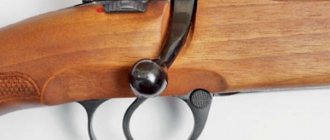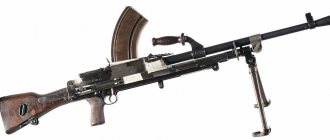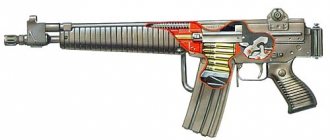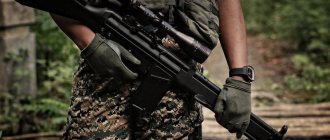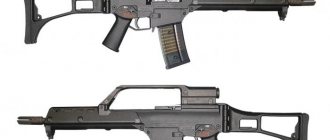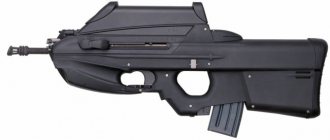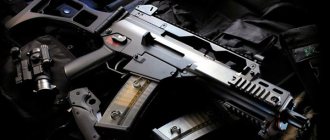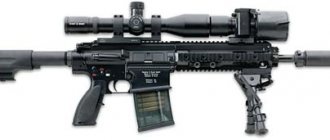Automatic Remington ACR (Bushmaster ACR)
Over the past few years, a huge number of laudatory reviews have appeared about the Bushmaster ACR assault rifle. This weapon is an excellent example of the implementation of a modular design, which allows not only to change the class of weapon by replacing individual parts, but also to change ammunition in a matter of minutes without special tools.
In general, calling the weapon Bushmaster ACR is not entirely correct. The fact is that this name is applicable only to the civilian version of this product, and since more people have access to civilian weapons, the name of the weapon has accordingly stuck. The weapon version for the military is designated Remington ACR, and initially the machine gun was designated as Magpul Masada ACWS.
Let's try to sort out this confusion.
How the Remington ACR (Bushmaster ACR) assault rifle came to be
It all started with the fact that Magpul decided to improve the design of the M16 to make the weapon easier to maintain, but everything grew into a more serious project, at least this version that the company adhered to.
In principle, you can believe this, since every person has encountered a situation where the desire to improve something leads to the fact that you begin to understand the imperfections of individual components and how easily it is possible to eliminate other shortcomings that you had not paid attention to before. There is only one thing that does not fit in this story - 4 months after the start of the project, a new fully viable product was presented, ready for launch into mass production.
It is possible, and this is just my guess and not a fact, that Magpul already had significant developments on new weapons, but did not have enough financial resources to complete the work. In this regard, I repeat once again, it is possible that funds were taken to upgrade the M16, which is a very promising direction in terms of return on profit, but this money was used to complete work on the new machine gun. And once again I repeat that this is just my guess.
One way or another, 4 months after the start of work on modernizing the M16, a new Magpul Masada ACWS assault rifle appeared (if you translate the abbreviation, you get something like an “adaptive combat weapon system”). Or rather, not even an assault rifle, but a whole complex of small arms consisting of 2 assault rifles chambered for 5.56x45 with barrel lengths of 368, 257 and the designation Carbine and SQB; a sniper rifle for the same ammunition with a barrel length of 457 millimeters and the designation SPR; machine gun chambered for 7.62x39 with the designation AK. A little later, a light machine gun chambered for 7.62x51 appeared, although it can only be called a machine gun within the framework of the domestic classification of weapons. All this could easily be transformed from one to another using interchangeable modules from which the weapon consists.
In 2008, Bushmaster Firearms International purchased a license for the entire result of the work of Magpul designers. After a minor modernization of the weapon, which consisted of a relocation of the charging handle, the new weapon appeared on the market under the name we know - Bushmaster ACR.
Weapon variants with barrel lengths of 318, 268, 406, 457 millimeters are appearing on the civilian market. Moreover, the number of ammunition for which the weapon can be adapted is significantly expanding, namely 5.56x45, 7.62x39, 6.8x43, 6.5x39 cartridges; at the moment, .300 AAS (7.62x35) has also been added to them. Given how popular weapons are, this list may expand. It goes without saying that for the civilian market all weapons are deprived of the ability to fire automatically.
Since the weapon very quickly proved that it could not only compete with well-known and trusted models, but also surpass them in certain characteristics, the military became interested in the machine gun. And this is where the confusion begins in Santa Barbara among American arms companies. The fact is that Bushmaster is part of the Freedom Group holding company, which includes Remington in all its guises. It was Remington that began supplying the modular ACR system to the US Army.
Thus, for the civilian market and for the army, weapons are offered by two different companies and the money goes into different wallets, only one wallet is in the right pocket and the other in the left.
It should be noted that the machine gun itself performed well in Afghanistan, that is, under significant temperature changes and not the cleanest conditions.
Design of the Remington ACR (Bushmaster ACR) assault rifle
Returning to the issue of modernizing the M16 in 4 months, it should be separately noted that the end result boasts an automation system different from the M16.
The weapon's automation is built around the removal of powder gases from the barrel with a short stroke of the gas piston and is virtually identical to that of the AR18. The AR18 assault rifle, as they say, is widely known in narrow circles. Those who are interested in firearms know the nickname “Widowmaker,” which the machine gun received due to its popularity in the IRA.
Despite the fact that the bolt and gas block of the weapon are represented by separate modules, each of them can be easily disassembled for repair and maintenance. The same applies to the trigger mechanism.
There is a very interesting fact about the trigger mechanism of this weapon. This is the only element that distinguishes the civilian Bushmaster ACR from the military Remington ACR and is represented by a separate module. That is, in order to obtain military weapons, it is enough to replace only a separate module, which in the event of global military operations can be useful in case of a shortage of weapons, which is unlikely, of course, but still.
The machine control elements are duplicated on both sides. The cocking handle can be installed on both the left and right sides, or even on both sides. But it is worth noting that during shooting the handle moves, unlike the same M16.
What is really quite useful is the presence of various options for butts for the machine gun; the standard butt, by the way, folds and does not interfere with firing the weapon, although it covers the fire mode switch on one side. Given the widespread use of lightly armored vehicles by the US Army, it becomes unclear how a weapon with a fixed stock could be in service at all.
If we talk about the modularity and ease of operation of this weapon, it should be noted that the designers coped with their initial official task - the weapon can be completely disassembled and reassembled without additional devices. Even the barrel can be replaced “on the knee”, and at medium distances there will be no need to zero the weapon - the deviations will be insignificant, even though the sighting devices are located on the receiver and forend.
A separate “trick” of this machine is that its mechanisms can operate without lubrication, but the manufacturer does not recommend abandoning lubrication completely, just a minimum of it is needed. This is achieved thanks to a special coating of individual elements of the weapon, which, in principle, is not an innovation and each manufacturer has its own composition and its own patented names with approximately the same performance characteristics as a result.
You can often find information about the incredible accuracy of this machine gun, comparable to the accuracy of a self-loading sniper rifle. On the contrary, there is no secret in this; this result is achieved by fitted parts of the weapon’s mechanisms, and most importantly, thanks to a high-quality barrel, the bore of which is chrome-plated. It is even stated that the thickness of the chromium layer is three times thicker than that of M4, which, in theory, should have a positive effect on durability. Speaking in numbers, this is 0.5-1 arc minutes with single shots. But these are the numbers given by the owners of this weapon; the manufacturer says nothing about this. Pros and cons of the Remington ACR (Bushmaster ACR) assault rifle
The main advantage of this machine gun is its high service life and stable characteristics for each weapon, which can rarely be found in any mass-produced product. The ability to adapt to specific needs, and most importantly to various ammunition, is also an indisputable plus. “Omnivorousness” of weapons with cartridges from different manufacturers, ease of maintenance - all this is and should be present in any weapon, but for some reason the presence of this must be highlighted separately as an advantage, and not as a self-evident fact.
The main disadvantage of this machine is its cost. Of course, for each individual module you can highlight individual negative aspects, but the beauty of modularity is that if you don’t like or are not satisfied with something, then this part is simply changed to another and as a result you can assemble a weapon not only suitable for specific tasks, but also completely tailored to the shooter's personal preferences.
Conclusion
In concluding an article about the Bushmaster ACR or Remington ACR assault rifle, one cannot fail to touch upon the topic of pricing. It is very doubtful that in production this weapon will be twice as expensive as other common production models, and the characteristics are clearly not phenomenal, but simply slightly higher than those of some other models. Despite this, the price tag of the machine gun is not at all slightly higher than that of the same M4.
If we draw any conclusions based on the design of the weapon, then we can say that there is nothing supernova in it, the weapon is simply made of high quality, not from scrap metal, with high precision and normal quality control.
It is impossible not to touch upon the topic of weapon modularity. For some reason, for most people, even the possibility of changing the barrel seems absolutely unnecessary for an assault rifle. And indeed, no one will carry with them interchangeable barrels of different lengths, much less change a long barrel on the go for a shorter one when entering a room, for greater maneuverability. It is even doubtful that anyone will change the same barrel immediately before combat, adapting the weapon for a specific situation. The main advantage of the modular system is that mass production of weapons is much cheaper.
We can take a simple example. Suppose we are armed with a machine gun, a light machine gun and an automatic sniper rifle of completely different designs. Each part of such a weapon must be made separately, and this not only requires man-hours and more workers, but also different production lines, or even different factories altogether.
Now let’s imagine that there is one receiver, which is completely the same for all three classes of weapons. There is a trigger mechanism that is the same for a machine gun and a machine gun. There is a bolt group that is suitable for both a sniper rifle and a machine gun. So the list can be continued endlessly. As a result, instead of making two or three different parts, you can make one identical one.
Not least important is quick repairs in the field, when from two, sometimes different, weapons with various breakdowns you can assemble one full-fledged one, and you don’t need to be a master gunsmith for this.
Even training in servicing weapons, which are not fundamentally different from each other, is an indisputable advantage of the modular system. So modularity is not a huge number of different unnecessary additions because there is nowhere to put the money. Modularity in firearms is precisely the ability to count and save money.
Assault rifle (automatic) model Magpul Masada ACWS / Bushmaster ACR
| Magpul Masada Carbine |
Magpul Masada CQB
In 2007, Magpul Industries Corp (a well-known manufacturer of weapons accessories in the United States) introduced its new development - an assault rifle of 5.56x45 mm caliber, called "Masada".
Developed in record time (4 months), the Masada project was initially intended to be a modernization of the appearance of the AR15 / M16 family of rifles. However, during the work process, the developers went further than expected. Instead of the usual update of well-known, but already quite outdated weapons, a completely new weapon was created. Magpul Industries engineers tried to take the best from the most successful and well-known assault rifles (FN SCAR, HK XM8, Colt M4) and combine it all in one body designed with the latest technology.
| Magpul Masada SPR |
Magpul Masada ACWS
The Magpul Masada assault rifle is one of the variants of the Magpul Masada ACWS (Adaptive Combat Weapon System) system, which allows you to change the caliber and class of weapons in a minimum amount of time and without the use of tools. Thus, a compact carbine can, at the shooter’s request, become a “full-size” machine gun or a tactical sniper rifle.
The Magpul Masada ACWS system consists of the following main weapon options:
— Carbine - a carbine with a barrel length of 14.5 inches (368 mm). The stock is combinable, folding and adjustable in length. The butt is equipped with a two-position adjustable cheek piece. — CQB – close-combat carbine, with a barrel length of 10.5 inches (267 mm). Equipped with a shortened version of the forend, with additional guides. - SPR - sniper version, with a barrel length of 18 inches (457 mm). Equipped with a PRS stock (manufactured by Magpul). Sniper stock - adjustable in length and height. - AK - Masada rifle, but chambered for 7.62x39 mm caliber (the cartridge used in the Kalashnikov AK-47 assault rifle). In addition to the barrel and bolt group in the AK, the lower receiver also changes.
| Magpul Massoud |
Thanks to the modular design of the Magpul Masada ACWS, all models are easily customizable.
In 2008, a modification of the Magpul Masada was introduced - the Magpul Massoud rifle in .308 Winchester caliber (7.62x51mm).
Technically, the Magpul Masada assault rifle is an automatic weapon of 5.56x45 mm caliber with a gas automatic engine (short stroke gas piston).
Magpul Masada ACWS interchangeable modules
The rifle consists of 6 main modules: a receiver (of 2 parts, upper and lower receiver), a bolt carrier with a bolt, a barrel with a gas release mechanism, a butt and a receiver lining.
The upper part of the receiver (the so-called upper receiver) is stamped from aluminum. Inside it are installed guides for the bolt frame, made of steel in the form of one piece. On the top of the receiver, along its entire length, there is a Picatinny rail, allowing the installation of various sighting devices. The lower receiver (lower part of the receiver) is made of high-strength polymer integral with the pistol grip and magazine receiver.
Magpul Masada ACWS incomplete disassembly
Trigger mechanism, almost identical to the trigger mechanism of AR15 / M16 rifles. Combined with a fuse and is a separate module in an aluminum housing. The USM is available in two interchangeable versions. The “combat” version provides single and automatic firing modes and is intended for army units, while the “civilian” version of the USM is only semi-automatic.
The fire mode translator lever is a two- or three-position fuse. Depending on the type of trigger, it is located above the trigger guard (same as on the M16) on both sides of the receiver.
The remaining controls, the magazine release and the bolt stop button, are also duplicated on the left side of the weapon. The magazine receiver is designed for NATO-standardized magazines from the M16.
| Carbine | |
| Caliber, mm | 5.56x45 NATO (.223 Rem) |
| Length, mm - butt unfolded and extended - butt unfolded and retracted - butt folded | 909 846 678 |
| Barrel length, mm | 368 |
| Weight, kg | 3.18 |
| Store, count. cartridges | 30 |
| Effective firing range, m | 500 |
The bolt, bolt carrier and recoil spring are also a separate module, but can be easily disassembled for cleaning and maintenance. The bolt is similar in design to the bolt of the M16 and AR 180 rifles. Locking is done by turning the bolt through 8 lugs. The charging handle is attached to the upper receiver, on the left side of the receiver, but if necessary can be easily moved to the right.
The Magpul Masada barrel is made of a quick-change module together with a gas exhaust system. The barrel can be changed without additional tools. It is possible to install barrels from M16.
The gas system is borrowed from the AR180 rifle designed by Eugene Stoner and is equipped with a three-position gas regulator. Like the bolt group, all parts of the gas exhaust system can be easily disassembled for cleaning.
A special pad made of the same polymer as the lower receiver is installed under the barrel to protect the shooter’s hands. The trim is available in two sizes; it is possible to install additional Picatinny rails, both below and on both sides of the trim.
To power the rifle with cartridges, PMAG magazines (developed by Magpul Industries) with a capacity of 30 rounds are used. This magazine is made of high-strength plastic and is equipped with a special window to monitor the presence of ammunition.
The rifle can be equipped with various stocks depending on the rifle version.
| Bushmaster Standard |
In January 2008, Bushmaster Firearms International, LLC announced that it had acquired the rights to manufacture the Magpul Masada ACWS.
Bushmaster ACR
The Magpul Masada rifle was modernized and put into production under the designation Bushmaster ACR (Adaptive Combat Rifle).
The main noticeable change after modernization was the relocation of the charging handle. The handle is now located above the barrel. Otherwise, the new weapon retains all the main features of the original.
The Bushmaster ACR is available in a variety of barrel lengths and three stock options.
The following models were developed as basic variants of the Bushmaster ACR:
- Standart - standard infantry rifle, with a barrel length of 16 inches (406 mm). — Carbine - a carbine with a barrel length of 14.5 inches (368 mm). - CQB (Close Quarters Battle) - a carbine for close combat, with a 12.5-inch (318 mm) barrel. — SPR (Special Purpose Rifle) is a tactical sniper rifle with an 18-inch (457 mm) barrel.
All Bushmaster ACR models are presented in 5.56x45 mm NATO caliber, but it is possible to expand the family with modules for 7.62x39 mm, 7.62x51mm and 6.8x43 mm (6.8 mm Remington SPC) calibers.
The Magpul Masada ACWS / Bushmaster ACR was produced by Bushmaster Firearms International, LLC.
| Bushmaster SPR |
